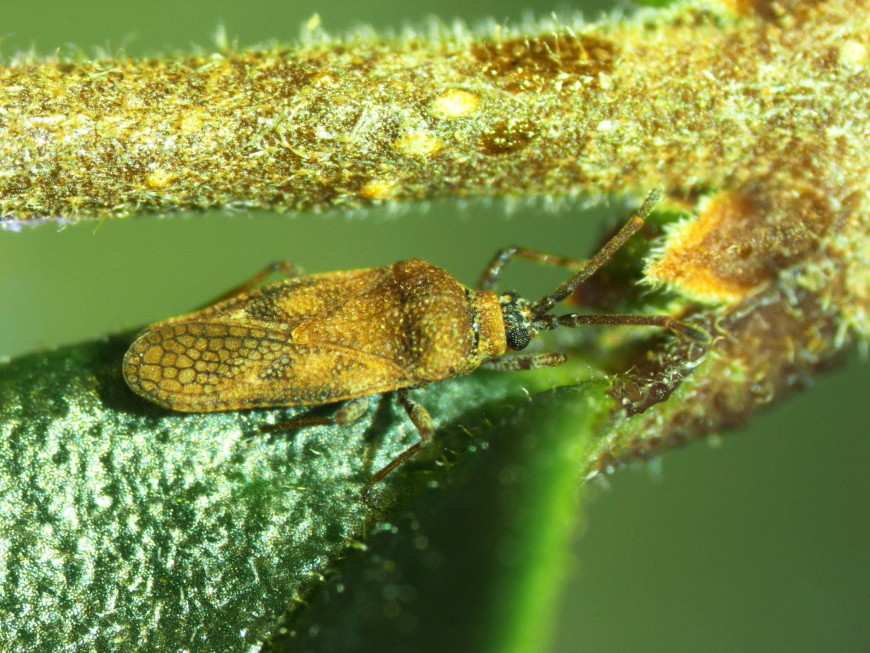Privet lacebug
History in New Zealand
Privet lace bugs are native to China. They were first imported by Manaaki Whenua-Landcare Research for study in 2013 and permission to release the lace bugs was granted by the EPA in 2015. The first field releases began in spring 2015 and establishment has been confirmed. The privet lace bug has not been used as a biocontrol agent anywhere in the world before.
How would I find/recognise them and what is their lifecycle?
Adult privet lace bugs are brownish-grey and are mottled with black. They are about 3 mm long and females are generally a bit longer and wider than males. Female lace bugs lay on average 240 eggs. You are unlikely to see the eggs without the aid of a microscope. Eggs are about 0.5 mm long and they are inserted into leaves and petioles so that the outer end is flush with the surface.

Image: adult privet lacebugs. Female (left) and male (right).
Juveniles are oblong, when looked at from above, and they are fairly flat. There are five juvenile instars and the newly moulted nymphs of each instar are initially pink but they darken as the cuticle hardens. Nymphs have very limited mobility, especially early instars which stay in the vicinity of where they hatch. Both the adults and nymphs should be relatively easy to spot during the warmer months. Look for signs of feeding damage on the leaves.
The privet lace bug overwinters as adult, coming out of diapause in spring. Since a generation can be completed in as little as 25 days, we expect this species will be able complete multiple generations here.
You are unlikely to confuse the privet lace bug with other insects. Another lace bug (Gargaphia decoris) has been introduced as a biocontrol agent for woolly nightshade (Solanum mauritianum). A native lace bug (Tanybyrsa cumberi) lives on Astelia species and an exotic lace bug (Stephanitis rhododendri) can be found on rhododendrons. There are no other insects on privet that you are like to confuse with the privet lace bug.
How do they damage privet?
Both the adults and the nymphs pierce and suck the mesophyll tissues from privet leaves resulting in a chlorotic and bleached appearance of the foliage. This can lead to defoliation and reduction of vigour of the plant.
Image: privet lacebug characteristic feeding pattern, beginning in the mid-leaf and moving outward.
Will they attack other plants?
In its native range the lace bug reportedly attacks a range of privet species in addition to Chinese privet and host-range testing has indicated that other Ligustrum species present in New Zealand are potential hosts. Laboratory testing results indicate that tree privet (Ligustrum lucidum) is a poor host, but it is not known to what extent other weedy forms of privet such as Ligustrum ovalifolium will be attacked. Some limited spill-over damage on lilac (Syringa spp.) may occur if there is privet nearby, however survival of the lace bug on lilac was very poor. No other plants are expected to be at risk.
How effective are they?
It is too soon to know what impact the privet lace bug will have in New Zealand. However, significant damage has already been observed on potted plants, and at shaded field sites. A similar insect, the woolly nightshade lace bug is beginning to outbreak and severely damage its host.
Image: early signs of damage in the field.
How can I get the most out of this agent?
If the lace bug establishes at the initial release sites, it will be worth helping to establish them in all areas where they are needed. The adults can fly but are likely to disperse fairly slowly, possibly only a few kilometres per year.
How do I select a release site?
Read Guidelines for selecting release sites for biocontrol agents.
How do I collect them for release at other sites?
When adults and nymphs are present in good numbers, cut infested leaf material and put it in a chilly bin or large paper rubbish bag. At the new site, wedge or tie the infested material firmly into Chinese privet plants so the lace bugs can move across. Shift at least 1000 individuals to each new site at any time during the warmer months. Release sites that are sheltered from cold winds (e.g., north facing hillsides and gullies) are recommended.
How do I manage the release sites?
Avoid any activities that will interfere with the lace bugs, such as herbicide application. If you need to undertake control measures, avoid the release site.


